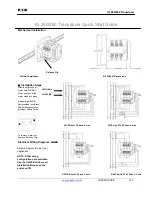
10
SEL-FT50/SEL-FR12 Fault Transmitter and Receiver System
Instruction Manual
Date Code 20210405
Application Examples
Improve Fuse-Blowing Schemes With the Fault Transmitter and Receiver
System
With the SEL-FT50/SEL-FR12 system installed as shown in
Figure 10
, the
recloser control receives an indication whenever a fault is on the unfused branch.
With this information, if a fault occurs on the unfused line section, the recloser
control can trip instantaneously instead of waiting for the fuse delay.
In
Figure 10
, the unfused tap is monitored by a set of SEL-FT50 Fault Transmit-
ters (one for each phase), one SEL-FR12, and one SEL-651R. The SEL-FR12 is
connected to the SEL-651R via a serial port.
When using the SEL-FT50/SEL-FR12 system, the SEL-651R knows when a
fault occurs on the unfused tap because one or more of the SEL-FT50 Fault
Transmitters detect the fault current and send the fault status to the SEL-FR12,
which then conveys the information to the recloser control.
The SEL-651R settings replace or modify the curve behavior while the fault is
happening. In the example fault shown in
Figure 10
, the recloser control enables
the recloser control fast curve (see
Figure 8
). Compare this to when a fault is on
the same unfused line section but the recloser control does not know it. The
recloser trips after a delay. Based on the coordination curves in
Figure 8
, for a
1000 A fault, using the SEL-FT50/SEL-FR12 system to trip on the fast curve
instead of the slow curve reduces the fault clearing time by 400 ms.
Fuse-Saving Combined With Fuse-Blowing Schemes
The fundamental choice in distribution-line protection is between fuse-saving
and fuse-blowing. For a given fault, designers either favor blowing fuses and dis-
rupting as few customers as possible, or tripping the recloser and interrupting the
fault without blowing any fuses. Each method has its advantages, but the protec-
tion planner has to pick one or the other.
Using the SEL-FT50/SEL-FR12 system, design smart protection that switches
from fuse-saving to fuse-blowing, or vice versa without interruption. You get the
fuse-saving or fuse-blowing benefits you want while eliminating any drawbacks.
Figure 9
Fault on Unfused Tap
R
Figure 10
SEL-FT50 on Unfused Tap
R
SEL-FR12
SEL-651R-2
When the fault is on the unfused branch, the recloser trips without fuse-coordination delay.
SEL-FT50











































